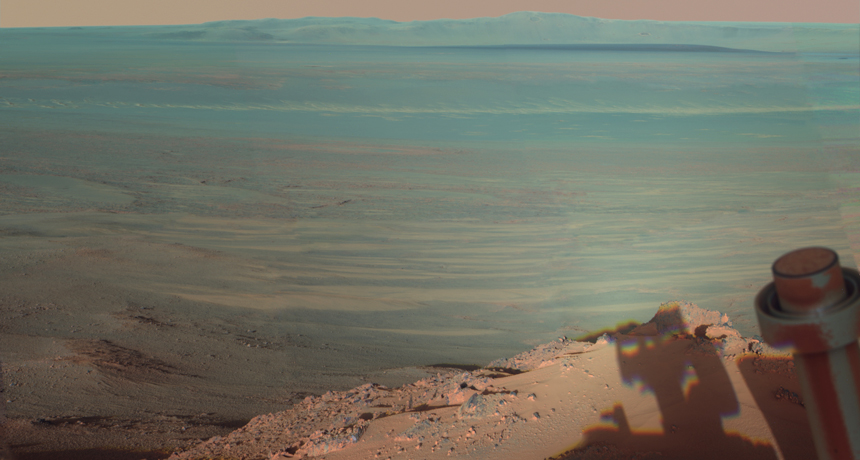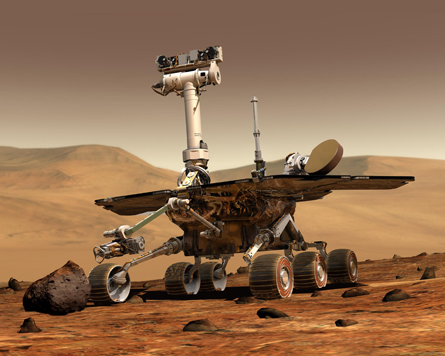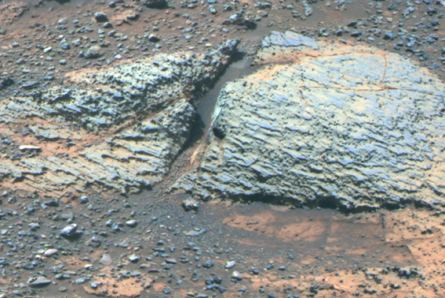Old rover finds new evidence of water on Mars
10-year-old Opportunity reveals chemistry that could have supported life

CRATER VIEW The 10-year-old Mars rover Opportunity casts a shadow over the planet’s Endeavour Crater, which holds traces of ancient water. The rover created this false-colored mosaic image in 2012 by combining pictures taken through different filters of its panoramic camera.
NASA/JPL-Caltech/Cornell/Arizona State Univ.
Ancient Mars may have been a friendlier place for life than scientists once suspected. The veteran Mars rover Opportunity has dug up evidence that groundwater flowed near a giant crater called Endeavour about 4 billion years ago.
And like the ancient lake that rookie rover Curiosity recently explored at Gale Crater (SN Online: 3/12/13), the water at Endeavour was just right for microbial life: not too acidic or salty for cells to thrive, researchers report in the Jan. 24 Science.
“At two landing sites on completely different sides of the planet, we now see evidence for these very benign, water-rich environments,” says Caltech planetary geologist Bethany Ehlmann, who is part of the Curiosity team. “That says a lot about how prevalent life could have been.”
Opportunity began searching for signs of microbe-friendly water a decade ago, when it landed on Mars with its twin rover, Spirit. Before the end of its planned three-month mission, Opportunity found evidence that salty, acidic water could have once pooled at Meridiani Planum, a smooth, flat Martian plain (SN: 3/6/04, p. 147).

Years later, the Mars Reconnaissance Orbiter picked up telltale signatures of iron-rich clay minerals — which form in the presence of mild water — in Endeavour Crater, more than 20 kilometers from the site where Opportunity had been exploring. Although Opportunity had been trucking along years longer than expected, scientists sent the rover in for a closer look.
In 2012, to direct the rover to the right spot, planetary geologist Raymond Arvidson of Washington University in St. Louis and colleagues sharpened images from the orbiter and mapped the iron-rich clay minerals to an outcrop of rocks on Endeavour’s rim. The minerals may have formed as slightly acidic water corroded basaltic rock, Arvidson says.
There, Opportunity found odd fractures cutting through the crater’s rocks. The rover ground into the fractures with its rock abrasion tool, a kind of rotating nail file, and measured their ingredients.
“The deeper we went, the more it looked like aluminum clay, which requires a whole lot more water to form,” Arvidson says.

This potentially habitable spot is part of a long history of water that Opportunity found at Endeavour Crater. Younger sandstone that overlies the ancient rocks also bears evidence of water, but a more acidic, less hospitable kind.
Though the environment at Endeavour Crater became more hostile over time, Ehlmann says, “there’s this record of a benign period of water flushing through these rocks.”
The new analysis comes almost exactly 10 years after Opportunity’s touchdown on the red planet on January 24, 2004. “I can’t believe this vehicle is still going,” Arvidson says. “But it’s a good American-made vehicle — it’s like a ’48 Chevy.”







